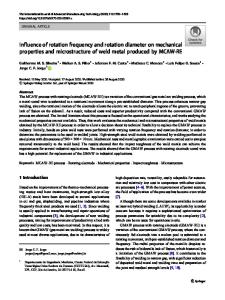Effects of Rotation Rates on Microstructure, Mechanical Properties, and Fracture Behavior of Friction Stir-Welded (FSW)
- PDF / 2,255,964 Bytes
- 14 Pages / 593.972 x 792 pts Page_size
- 4 Downloads / 391 Views
INTRODUCTION
MAGNESIUM alloys are the lightest structural alloys that are commercially available. Nowadays, magnesium alloys have gained huge interest in the aircraft and automobile industries because of the need of weight reduction. Therefore, a reliable welding process is required to support these applications. However, conventional fusion welding has some problems, such as porosity, oxidization, a wide heat-affected zone, and high residual stress, which limit the use of the magnesium alloys. Friction stir-welding (FSW), a solid joining method,[1] can eliminate the welding problems in conventional fusion welds, and therefore has been successfully used to weld various magnesium alloys, such as Mg-Al-Zn alloys,[2–12] Mg-Zn-Y alloys,[13,14] and Mg-Al-Ca alloy.[15] Among these magnesium alloys, AZ31, a widely used wrought magnesium alloy, has been widely subjected to FSW investigations.[2–12] These studies can be classified into two categories. Some studies were focused on the mechanical properties of FSW joints.[2–9] The others paid attention to the texture variation and material flow patterns during FSW.[10–12] In the early studies of FSW AZ31,[2–4] the optimization of welding parameters was an important issue. J. YANG, Postgraduate, D. WANG, Assistant Professor, B.L. XIAO and Z.Y. MA, Professors, and D.R. NI, Associate Professor, are with the Shenyang National Laboratory for Materials Science, Institute of Metal Research, Chinese Academy of Sciences, Shenyang 110016, P.R. China. Contact e-mail: [email protected] Manuscript submitted January 21, 2012. Article published online August 22, 2012 METALLURGICAL AND MATERIALS TRANSACTIONS A
Most studies were conducted on AZ31-H24 plates, and joint efficiencies (UTSJoint/UTSPM) in the range of 6085 pct were obtained by changing the rotation rate and welding speed.[2,3] However, among these studies,[2–4] there was no concordant conclusion on the relationship between the mechanical properties and the rotation rate and welding speed. Later, Commin et al.[5] found that the joint properties were related to the heat input, and high heat input was favorable for good joint properties. Afrin et al.[6] and Wang et al.[7] reported that the ultimate tensile strength (UTS) of the FSW joints increased as the rotation rates increased from 500 to 1500 rpm for both the H24 and hot-rolled AZ31. Furthermore, Yang et al.[9] found that higher UTS was obtained with a larger diameter shoulder because of greater heat input. The texture of the magnesium alloys is sensitive to severe plastic deformation because the number of independent slip systems in the hexagonal close packed (HCP) structure is limited.[16] Park et al.[17] observed a strong texture development in FSW AZ61 and suggested that the basal plane was roughly aligned with the pin surface in the nugget zone (NZ). A similar result was also found in the FSW AZ31 by Woo et al.[10] Besides, the fracture location of the joints was usually located at the thermo-mechanically affected zone (TMAZ), which was attributed to the texture development.[10,18]
Data Loading...











